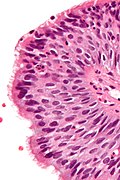Nasal polyps
Jump to navigation
Jump to search
Nasal polyps are a common head and neck lesion. They are typically benign but may be malignant.
Overview
DDx (benign - multiple):[1]
- Autoimmune/idiopathic:
- Asthma.
- Allergic rhinitis.
- Churg-Strauss syndrome (AKA allergic granulomatous angiitis).
- Features: asthma, eosinophilia, granulomatous inflammation, necrotizing systemic vasculitis, and necrotizing glomerulonephritis.[2]
- Nonallergic rhinitis with eosinophilia syndrome (NARES).
- Infectious:
- Fungal infection (with allergic component - AFS = allergic fungal sinusitis).
- Chronic rhinosinusitis.
- Genetic:
- Primary ciliary dyskinesia.
- Cystic fibrosis.
- Associations:
- Alcohol intolerance ~ 50%.
- Aspirin intolerance - upto ~ 25%.
- Tumours:
- Juvenile nasopharyngeal angiofibroma - young males.
- Nasopharyngeal carcinomas.
- Sarcomas.
- Hemangioma.
- Schneiderian papilloma.
- Other.
Memory devices:
- GAIT = Genetic, Allergic/idiopathic, Infectious, Tumours.
- Allergic causes As - allergic, asthma, allergic granulomatous angiitis (Churg-Strauss syndrome), nonallergic rhinitis with eosinophilia.
Epidemiology
- More commonly assoc. with nonallergic conditions.[1]
Treatment
- Recurrent polyps: functional endoscopic sinus surgery (FESS).
Inflammatory polyps with neutrophils
General
- Histologic findings are non-specific; DDx includes:[3]
- Cystic fibrosis.
- Primary ciliary dyskinesia syndrome.
- Young syndrome
Microscopic
Features:
- Neutrophil predominant.
- Edema.
- +/-Mucus-impaction (dilated glands with mucus).
- Suggestive of cystic fibrosis.[4]
Sign out
A. Nasal sinus tissue, right, excision: - Inflamed edematous sinonasal mucosa with abundant neutrophils. - Negative for malignancy. B. Nasal sinus tissue, left, excision: - Inflamed edematous sinonasal mucosa with abundant neutrophils and fragments of bone. - Negative for malignancy.
Alternate
A. Contents of Left Ethmoid Sinus, Excision:
- Mildly inflamed sinonasal mucosa with bone and fibrous tissue.
- NEGATIVE for malignancy.
B. Contents of Right Ethmoid Sinus, Excision:
- Mildly inflamed sinonasal mucosa with bone and fibrous tissue.
- NEGATIVE for malignancy.
Allergic nasal polyp
General
- People with allergies.
- Same type of polyps seen in those without allergies.[5]
Gross
- Polypoid mass - several millimetres to centimetres in size.
- Translucent.[citation needed]
Microscopic
Features:[6]
- Normal respiratory epithelium.
- Stroma with:
- Edema.
- Eosinophils.
- +/-Other inflammatory cells (plasma cells, lymphocytes, neutrophils).
DDx:
- Inflammatory nasal polyp with abundant neutrophils.
- Vasculitis.
- Biphenotypic sinonasal sarcoma - has hypercellular stroma.
Sign out
A. Left Nasal Polyp, Excision: - Inflamed edematous sinonasal mucosa with abundant eosinophils. - NEGATIVE for malignancy. B. Right Nasal Polyp, Excision: - Inflamed edematous sinonasal mucosa with abundant eosinophils and fragments of bone. - NEGATIVE for malignancy.
A. Nasal sinus tissue, right, excision: - Inflamed edematous sinonasal mucosa with abundant eosinophils. - Negative for malignancy. B. Nasal sinus tissue, left, excision: - Inflamed edematous sinonasal mucosa with abundant eosinophils and fragments of bone. - Negative for malignancy.
Block letters
A. NASAL SINUS TISSUE, RIGHT, EXCISION: - INFLAMED EDEMATOUS SINONASAL MUCOSA WITH ABUNDANT EOSINOPHILS. - NEGATIVE FOR MALIGNANCY. B. NASAL SINUS TISSUE, LEFT, EXCISION: - INFLAMED EDEMATOUS SINONASAL MUCOSA WITH ABUNDANT EOSINOPHILS AND FRAGMENTS OF BONE. - NEGATIVE FOR MALIGNANCY.
Schneiderian papilloma
General
- Lumpers vs. splitters debate about whether it is one entity or three.[8]
- Inverted (Schneiderian) - most common ~60-65%.
- Fungiform (Schneiderian) - less common ~30-35%.
- Oncocytic (Schneiderian) - least common ~5%.
Inverted
- AKA inverted papilloma.[9]
- Usually lateral wall (as the septum as little soft tissue to grow into).[8]
- May transform to carcinoma.
Fungiform
Oncocytic
Microscopic
Inverted Schneiderian papilloma
Features:[8]
- Well-demarcated epithelial islands in the stroma.
- Squamous +/-surface keratinization or respiratory type epithelium (with cilia).
- +/-Neutrophils.
- +/-Goblet cells.
Notes:
- May mimic invasive SCC.
Images
Fungiform Schneiderian papilloma
Features:
- Exophytic growth pattern - key feature.
Oncocytic Schneiderian papilloma
Features:
- Oncocytes - key feature.
- Exophytic or endophytic growth pattern.
Antrochoanal polyp
- Abbreviated ACP.
General
Epidemiology:
- "Almost always" recur if incompletely excised.[12]
- Originates from maxillary sinus and extends to choana.[13]
Gross
- Solid and cystic.[11]
Microscopic
Features:
- Respiratory epithelium.
See also
References
- ↑ 1.0 1.1 URL: http://emedicine.medscape.com/article/994274-overview. Accessed on: 16 March 2011.
- ↑ http://emedicine.medscape.com/article/333492-overview
- ↑ URL: http://emedicine.medscape.com/article/994274-diagnosis. Accessed on: 16 March 2011.
- ↑ Beju D, Meek WD, Kramer JC (April 2004). "The ultrastructure of the nasal polyps in patients with and without cystic fibrosis". J. Submicrosc. Cytol. Pathol. 36 (2): 155–65. PMID 15554502.
- ↑ Davidsson, A.; Hellquist, HB. (1993). "The so-called 'allergic' nasal polyp.". ORL J Otorhinolaryngol Relat Spec 55 (1): 30-5. PMID 8441521.
- ↑ Klatt, Edward C. (2006). Robbins and Cotran Atlas of Pathology (1st ed.). Saunders. pp. 144. ISBN 978-1416002741.
- ↑ URL: http://emedicine.medscape.com/article/862677-overview. Accessed on: 19 November 2011.
- ↑ 8.0 8.1 8.2 8.3 8.4 8.5 Barnes L (March 2002). "Schneiderian papillomas and nonsalivary glandular neoplasms of the head and neck". Mod. Pathol. 15 (3): 279–97. doi:10.1038/modpathol.3880524. PMID 11904343. http://www.nature.com/modpathol/journal/v15/n3/full/3880524a.html.
- ↑ Vrabec, DP. (May 1994). "The inverted Schneiderian papilloma: a 25-year study.". Laryngoscope 104 (5 Pt 1): 582-605. PMID 8189990.
- ↑ Bravo Domínguez, O.; Vela Cortina, M.; Ramírez Ruiz, RD.; Ros Vergara, A.; Dinarés Jaumeandreu, D.; Encina Ruiz, L.; Arias Cuchí, G.; Ardíaca Bosch, MC. et al. (2005). "[Oncocytic schneiderian papilloma. A case report].". An Otorrinolaringol Ibero Am 32 (2): 115-23. PMID 15929584.
- ↑ 11.0 11.1 "The antrochoanal polyp". Rhinology 42 (4): 178–82. December 2004. PMID 15626248.
- ↑ 12.0 12.1 "Antrochoanal polyp: analysis of 200 cases". Acta Otorhinolaryngol Ital 29 (1): 21–6. February 2009. PMC 2689564. PMID 19609378. https://www.ncbi.nlm.nih.gov/pmc/articles/PMC2689564/.
- ↑ "Antrochoanal polyposis: analysis of 34 cases". Eur Arch Otorhinolaryngol 270 (5): 1651–4. May 2013. doi:10.1007/s00405-012-2274-2. PMID 23179936.

